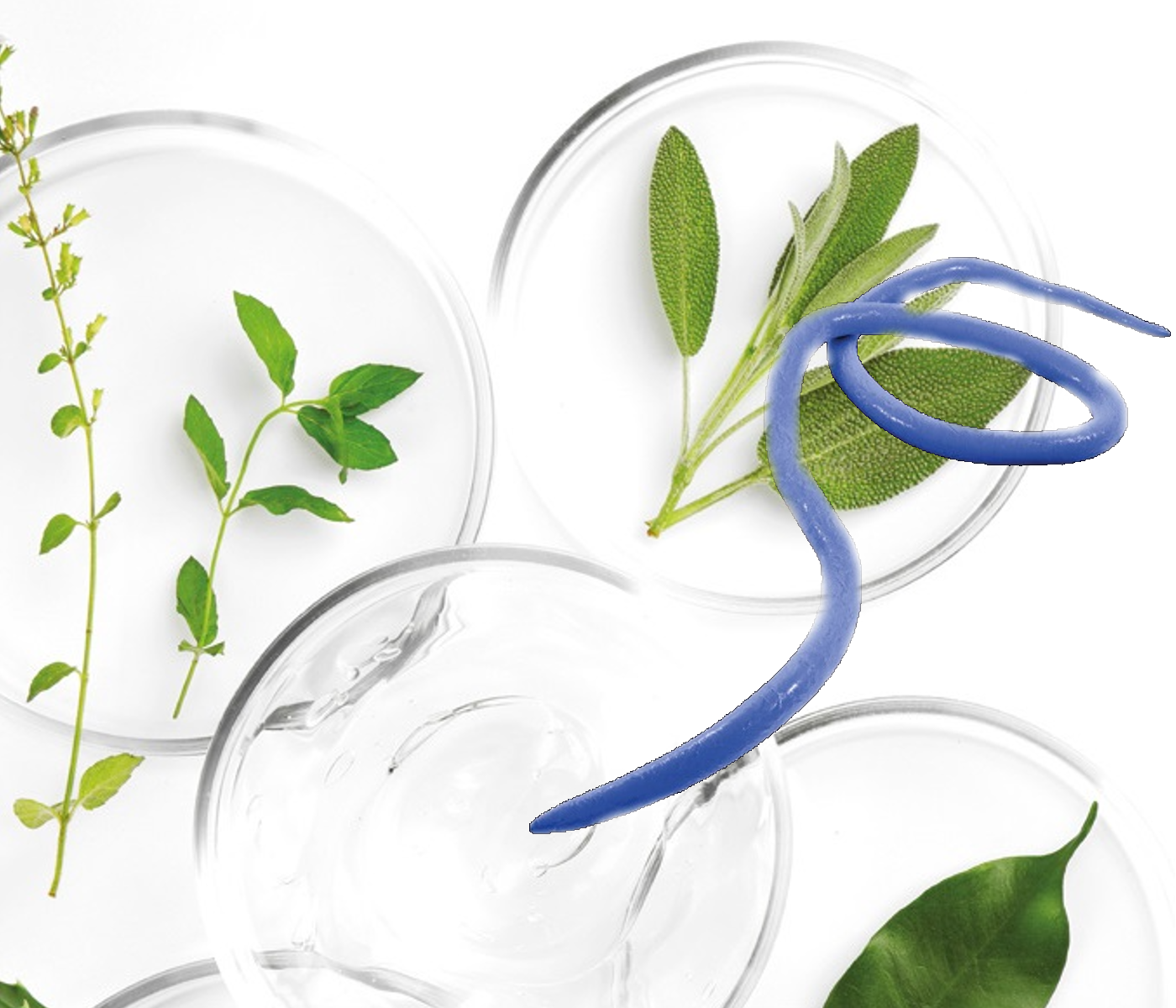 01 Mar 2023
01 Mar 2023
Integrated control of gastrointestinal nematodes in small ruminants
Any production system of sheep and/or goats whose food source is based on the use of pastures invariably faces the presence of gastrointestinal nematodes (GIN).
Infection caused by gastrointestinal nematodes are still considered as one of the greatest health threats for sheep and goat herds. Negatively impacting the viability and profitability of such production systems (1,2).

This situation is aggravated by the emergence of GI nematode strains that are resistant to conventional anthelmintics (AH) (3,4). These strains tend to be resistant to the most recent active ingredients on the market which represents major problem (5,6,7,8).
Losses caused by the infestation of gastrointestinal nematodes and their associated costs are estimated to be in the order of €151, €206 million and €86 million in dairy, meat and dairy goat sheep, respectively (9).
Within this wide range of strategies, we can mention:
![]() Rational use of AH(11,12)
Rational use of AH(11,12)
![]() Nutritional supplementation (13,14)
Nutritional supplementation (13,14)
![]() Genetic selection (15,16)
Genetic selection (15,16)
![]() Immunization (17,18)
Immunization (17,18)
![]() The use of copper oxide needles (19,20)
The use of copper oxide needles (19,20)
![]() Grassland rotation (21)
Grassland rotation (21)
![]() Bio-control (22,23)
Bio-control (22,23)
![]() the study of AH properties found in certain plant species (24,25,26)
the study of AH properties found in certain plant species (24,25,26)
Invariably, all plant species produce different amounts and concentrations of certain elements that possess multiple biological functions, known as secondary plant metabolites (SPMs).
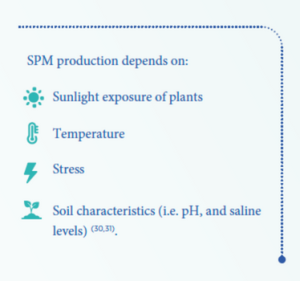
Due to the heterogeneity of their chemical composition, there are different classification methods. However, these compounds can be broadly classified in three large functional groups:
![]() Alkaloids: This family of secondary plant metabolites is composed of approximately 20,000 identified structures
Alkaloids: This family of secondary plant metabolites is composed of approximately 20,000 identified structures
![]() Phenolic compounds: Within this group, condensed tannins have received special attention due to their AH activity and their presence in several plant species (43,44,45).
Phenolic compounds: Within this group, condensed tannins have received special attention due to their AH activity and their presence in several plant species (43,44,45).
![]() Terpenes:These represent the largest group of SPMs with approximately 80,000 identified structures (46), and their AH properties are the subject of this review.
Terpenes:These represent the largest group of SPMs with approximately 80,000 identified structures (46), and their AH properties are the subject of this review.
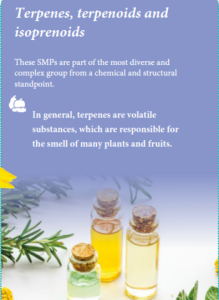
Essential Oils (EOs) are very heterogeneous in regards to their chemical composition and the multitude of properties that have been attributed to them. Therefore, they are widely used in: the pharmaceutical, cosmetic, veterinary and livestock industries.
EOs can be obtained from various plant resources (leaves, flowers, stems, fruits, pods, seeds, roots and bark) or from animals (marine organisms). They represent lipophilic mixtures containing a variety of chemical compounds.
Therefore, we can consider EOs as oily substances containing different types of SPMs.
Finally, although their bioactive effects can be attributed to major components, synergies between various SPMs should be considered and studied.
It must be emphasized that there are still no official guidelines that determine the efficacy of natural products in ruminants.
 Consequently, the work carried out to date has been based on official guidelines to determine the effectiveness of synthetic products (73) or on publications from experts in the field (74).
Consequently, the work carried out to date has been based on official guidelines to determine the effectiveness of synthetic products (73) or on publications from experts in the field (74).
This type of strategy includes the study of AH properties found in plants or their extracts. Evaluating their effect on GI nematodes during different stages of their biological cycle. These assessments have been made at laboratory level, and therefore are regarded as in vitro trials.
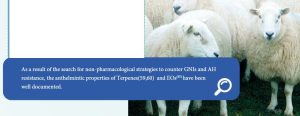
In vitro tests tend to have lower costs, yield faster results and provide the possibility of examining a relatively large number of compounds within a short period of time (75).
However, these tests do not address the multifactorial nature of animal physiology in which:
1- There are special dynamics involved with the amounts and concentrations of chemicals that enter the digestive system
2- The rate and sequence in which SPMs enter and are processed is variable and dynamic
3- In order to achieve similar results to those observed under in vitro conditions, animals require a high consumption of fresh plant material to match the concentrations that yielded positive results.
4-Rumen microbial populations have the ability to develop adaptations to SPMs.
Therefore, due to the difficulty of replicating these factors, host testing is the best alternative for determining the AH properties of plants and their derivatives (75).
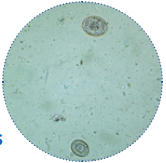
For the development of the in vivo approach in the evaluation of the AH activity of natural products, two methodologies can be implemented (72):
The bioactive compound is administered to a group of animals and the excretion of eggs per gram (EPG) of GIN is quantitatively monitored over a period of time (pre and post).
It has the same fundamentals as the FECRT. However, it is mandatory to establish a control group, where humane euthanasia of the animals is carried out, in order to recover the organs of the GI tract where adult GINs are found.
Subsequently, counts of GIN populations must be performed as well as measurements in recovered GINs, allowing a comparison between experimental groups.

FECRT was used in all papers including this review. The results in EPG counts after the administration of TRPs or EOs were variable. Evidencing that AH activity can be classified as:
Although these results derive from a small number of studies and are somewhat ambiguous; they attest to the potential of these alternative compounds and the possibility of employing them as therapeutic agents in small ruminants.
Ketzis et al. (62) and Katiki et al. (66), found that the administration of EOs derived from Chenopodium ambrosioides and Cymbopogon schoenantun respectively, had no effect on the number of adult GINs recovered at necropsy.
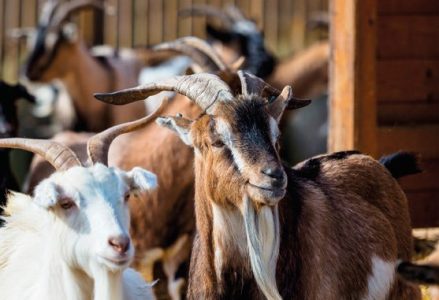
Significant results were reported by Camurca et al. (61)mentioning a certain level of selectivity on the populations of Haemonchus contortus by EOs derived from Lippia sidoides.
The use of EOs derived from the fruits of Zanthoxylum zanthoxyloides (70) and an encapsulated solution of anethole and carvone (terpenes) (72) reduced:
The mechanisms of action by which terpenes or EOs act affect GINs are still unknown. However, it has been proposed that the cell membrane of these parasites is the primary target due to its hydrophobic nature(76).
These compounds enter the structures of gastrointestinal nematodes through transcuticular diffusion, interfering with metabolism and impeding vital functions, which include certain locomotion mechanisms (77).
According to López and Pascual-Villalobos (78), EOs exhibit activity in acetylcholinesterase receptors present in vertebrates and invertebrates. Producing a similar neurotoxic damage to that caused by organophosphates.
Research and development of natural products with AH properties has emerged as a response to growing populations of resistant gastrointestinal nematodes.
 During this review, the existence of ivermectin-resistant GIN populations became evident when reductions in EPG clearance of 67 – 85% (63), 35 – 54% (62) and 25% (67) were reported.
During this review, the existence of ivermectin-resistant GIN populations became evident when reductions in EPG clearance of 67 – 85% (63), 35 – 54% (62) and 25% (67) were reported.
The study of these parasitological variables can be complemented by the monitoring of physiological variables and productive variables such as daily weight gain (ADG) and feed conversion(FCR).
![]() In this regard, Whitney et al. (67) report a decrease in weight gain following the inclusion of 30% of Juniperus pinchotii in a balanced lamb diet.
In this regard, Whitney et al. (67) report a decrease in weight gain following the inclusion of 30% of Juniperus pinchotii in a balanced lamb diet.

Currently, there are about 80,000 plants which have been shown to have properties that can influence animal health and productivity (82) to some extent. Therefore, it is necessary to understand the nature of their interactions with herbivores in order to establish their applicability as nutritional and pharmaceutical alternatives. Offering beneficial effects for sheep and goat production systems (83,84).
Future research should be conducted to evaluate those what factors influence the bioactive properties found in these natural compounds. Including factors like:
Factors related to the animals per se, such as the administration route, productive activity, nutritional plan, physiological state and level of adaptation to SPM should also be considered.
Subscribe now to the technical magazine of animal nutrition
AUTHORS

Nutritional Interventions to Improve Fertility in Male Broiler Breeders
Edgar Oviedo
The Use of Organic Acids in Poultry: A Natural Path to Health and Productivity
M. Naeem
Synergistic Benefits of Prebiotics and Probiotics in Poultry, Swine, and Cattle
Gustavo Adolfo Quintana-Ospina
Hybrid Rye Potential in Laying Hen Feed Rations
Gwendolyn Jones
A day in the life of phosphorus in pigs: Part I
Rafael Duran Giménez-Rico
Use of enzymes in diets for ruminants
Braulio de la Calle Campos
Minerals and Hoof Health in the Pregnant Sow
Juan Gabriel Espino
Impact of Oxidized Fats on Swine Reproduction and Offspring
Maria Alejandra Perez Alvarado